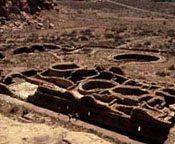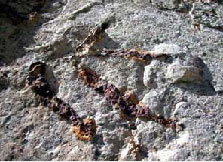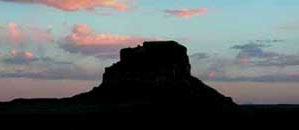HOW OLD IS IT?
Nothing is more apparent at Chaco Canyon than the passage of time. The crumbling walls of the
Great Houses
stand as a patent reminder that this desolate canyon once bustled with human activity.
For scientists interested in the "
Chaco Phenomenon
," establishing a precise timeline of events at Chaco is crucial. If we know when key developments took place, we can begin to piece together the history of this group of people who left behind prodigious artifacts, but no written record.
 And how do scientists go about solving the riddle of the ages? The dating techniques used are as different as the relics to which they are applied. Read on for a closer look at how we find answers to that perpetual question: How old is it?
And how do scientists go about solving the riddle of the ages? The dating techniques used are as different as the relics to which they are applied. Read on for a closer look at how we find answers to that perpetual question: How old is it?
The Canyon
Stroll atop the cliffs surrounding Chaco Canyon and you’ll notice strange, rust-colored branching tubes embedded in the sandstone.
 Though they look like rusty rebar, these are fossilized casts of tunnels made by some truly ancient denizens of the area, a burrowing shrimplike crustacean called Callianasa major.
Though they look like rusty rebar, these are fossilized casts of tunnels made by some truly ancient denizens of the area, a burrowing shrimplike crustacean called Callianasa major.
Huh? Shrimp in New Mexico? These burrows were dug some seventy million years ago, when a shallow sea covered the area. As the ocean receded, heavy particles suspended in the seawater (mainly iron, mercury, and other minerals) collected in the burrows and hardened to form metallic casts of the branching tunnels. Sharks’ teeth and clamshells in the sandstone are further evidence of the ocean that once covered the area.
 Geologists know the age of these and other rocks and fossils thanks to an arsenal of dating techniques.
Radiometric dating
uses the predictable decay of naturally occurring radioactive elements to establish the age of rocks. To establish the relative age of rocks, geologists compare layers in the rock (a technique called stratigraphy) and also look for index fossils, fossils of organisms that are known to have lived within a narrow time range.
Geologists know the age of these and other rocks and fossils thanks to an arsenal of dating techniques.
Radiometric dating
uses the predictable decay of naturally occurring radioactive elements to establish the age of rocks. To establish the relative age of rocks, geologists compare layers in the rock (a technique called stratigraphy) and also look for index fossils, fossils of organisms that are known to have lived within a narrow time range.
 The rock that comprises Chaco Canyon is sedimentary, built from layers of compacted ocean sediment. Sedimentary rock is difficult to date absolutely using radiometric dating, because it is composed of tiny bits of many types of preexisting rocks, all of various ages. To date sedimentary rock, geologists correlate fossil-bearing rock samples with other samples having both the same fossils as well as nearby layers of igneous rock—such as those formed by lava flows—which can be dated radiometrically.
The rock that comprises Chaco Canyon is sedimentary, built from layers of compacted ocean sediment. Sedimentary rock is difficult to date absolutely using radiometric dating, because it is composed of tiny bits of many types of preexisting rocks, all of various ages. To date sedimentary rock, geologists correlate fossil-bearing rock samples with other samples having both the same fossils as well as nearby layers of igneous rock—such as those formed by lava flows—which can be dated radiometrically.
Next: The Great Houses -->



 And how do scientists go about solving the riddle of the ages? The dating techniques used are as different as the relics to which they are applied. Read on for a closer look at how we find answers to that perpetual question: How old is it?
And how do scientists go about solving the riddle of the ages? The dating techniques used are as different as the relics to which they are applied. Read on for a closer look at how we find answers to that perpetual question: How old is it?
 Though they look like rusty rebar, these are fossilized casts of tunnels made by some truly ancient denizens of the area, a burrowing shrimplike crustacean called Callianasa major.
Though they look like rusty rebar, these are fossilized casts of tunnels made by some truly ancient denizens of the area, a burrowing shrimplike crustacean called Callianasa major.
 Geologists know the age of these and other rocks and fossils thanks to an arsenal of dating techniques.
Geologists know the age of these and other rocks and fossils thanks to an arsenal of dating techniques.
 The rock that comprises Chaco Canyon is sedimentary, built from layers of compacted ocean sediment. Sedimentary rock is difficult to date absolutely using radiometric dating, because it is composed of tiny bits of many types of preexisting rocks, all of various ages. To date sedimentary rock, geologists correlate fossil-bearing rock samples with other samples having both the same fossils as well as nearby layers of igneous rock—such as those formed by lava flows—which can be dated radiometrically.
The rock that comprises Chaco Canyon is sedimentary, built from layers of compacted ocean sediment. Sedimentary rock is difficult to date absolutely using radiometric dating, because it is composed of tiny bits of many types of preexisting rocks, all of various ages. To date sedimentary rock, geologists correlate fossil-bearing rock samples with other samples having both the same fossils as well as nearby layers of igneous rock—such as those formed by lava flows—which can be dated radiometrically.